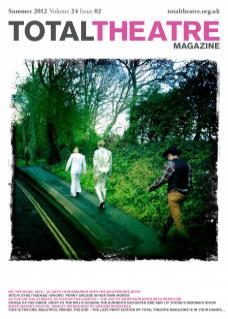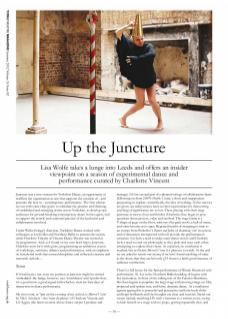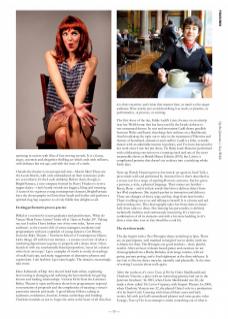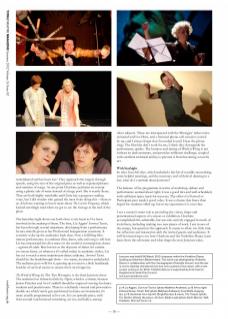Juncture was a new venture for Yorkshire Dance, an opportunity to reaffirm the organisation as one that supports the creation of – and presents the best in – contemporary performance. The first edition set out with some clear goals: to stimulate the practice and thinking of established and emerging artists across Yorkshire, to develop new audiences for ground-breaking contemporary dance in the region, and to support the artistic and curatorial practice of the lead artist and collaborators involved.
Under Wieke Eringa’s direction, Yorkshire Dance worked with colleagues at Leeds Met and Northern Ballet to present the season, while Charlotte Vincent of Vincent Dance Theatre was invited as its programmer. And, as I found on my own brief trip to Juncture, Charlotte went for it with gusto, programming an ambitious season of workshops, seminars, debates and performances, with an emphasis on female-led work that crossed disciplines and reflected a mature and maverick outlook...
To war
If it had been a war-zone my position at Juncture might be termed ‘embedded’. My badge, however, says ‘contributor’ and I prefer that; it’s a good term, a good signal with which to start my four days of immersion in dance performance.
My first event, at 7pm on the evening of my arrival, is Blurred Vision by V&A Artefacts – the ‘nom de plume’ of Charlotte Vincent and Liz Aggiss (the latter an artist whose dance output I produce and manage). It’s the second part of a planned trilogy of collaborative duets (following on from 2009’s Double Vision), a short and snappy piece purporting to explore, scientifically, the idea of nothing. At the start we are given our ticket money back as their expectations for discovering anything of significance are so low. Then, playing with their stage personae as mover (Liz) and thinker (Charlotte) they begin to pose questions about process, value and method. The stage frame is a V-shape of pegs on the floor, with two flat-pack stools, a ball of twine, and some brooms at its apex. Repeated motifs of sweeping in time to an extract from Prokofiev’s Romeo and Juliet, of chanting ‘om’ in unison, and of discussion interspersed with toil provide the performance’s structure. Liz feels a need to make some dance-moves and Charlotte feels a need to read out philosophy as they push and tease each other, attempting to explore their thesis. As expected, no conclusion is reached, but as theatre Blurred Vision is a pleasure to watch. At the end we are asked to return our money if we have found anything of value in the show; that they are left only £15 short is a fairly good measure of audience satisfaction.
There’s a full house for the 8pm performance of Wendy Houston’s solo performance 50 Acts in the Northern Ballet building. It begins with her motionless, in front of the rolling text of the Futurist Manifesto. She then begins to populate the large stage with moving image on film, projected and spoken text, and feisty, dynamic dance. As a retaliation against ageing this is powerful and persuasive stuff; the body shifts and leaps brilliantly and the thoughts are clear and succinct. Stand-out scenes include smashing LPs with a hammer to a written score, trying to hide herself on a stage with no props, getting repeatedly shot, and sprinting in unison with film of fast-moving crowds. It is a funny, angry, eccentric and altogether thrilling act which ends with stillness, with defiance but not ego, and with the trace of a smile.
Outside the theatre is an unexpected treat – Morris Men! These are the Leeds Morris, with owls embroidered on their waistcoats (owls are everywhere; it’s the Leeds emblem). Before them, though, is BrightFurnace, a new company formed by Harry Theaker to revive rapper dance – that’s bendy swords not baggies, bling and swearing. A team of six vigorous young contemporary dancers, BrightFurnace have the choreography well into their heads and bodies and perform a spirited clog/tap sequence to a lively fiddle that delights us all.
Exciting performative process-practice
Billed as a session for recent graduates and practitioners, ‘What do Venues Want From Artists?’ kicks off at 11am on Friday 24th. Taking my seat I realise I have broken one of my own rules, ‘know your audience’, as the room is full of venue managers, marketers and programmers with just a sprinkle of young dancers. Ceri Brierly, from the Riley Theatre / Northern School of Contemporary Dance, kicks things off with her ten minutes – a concise overview of what a marketing department requires to properly sell a dance show. I then launch in with my unashamedly biased proposition, ‘never let a dancer write their own copy’. I give examples of words to avoid, do readings of really bad copy, and make suggestions of alternative phrases and expressions. I am heckled. I get some laughs. The dancers, reassuringly, take notes.
Dave Edmunds of Dep Arts doesn’t hold back either, explaining how touring is changing and outlining the best methods for getting known and making relationships. Victoria Firth from the Lawrence Batley Theatre is open and honest about how programmers respond to mountains of proposals and the complexities of meeting a venue’s particular mission and needs. A good debate follows, taking in audiences, residencies, location, format, technology and funding. Charlotte reminds us not to forget the artist at the heart of all this; that it is their creativity and vision that matters here, as much as the target audience. Wise words; just avoid describing it as work, or practice, or performative, or process, or exciting.
The first show of the day, Eddie Ladd’s Llain, focuses on an airstrip near her Welsh home that has been used by the Israeli airforce to test unmanned drones. In text and movement Ladd draws parallels between Wales and Israel, sketching their outlines on a blackboard, then broadening the topic out to take in the treatment of Palestine and themes of homeland, alienation and conflict. Ladd is a lithe, versatile dancer with an admirable interest in politics, and I’ve been interested in her work since I saw her last show, The Bobby Sands Memorial (performed with exhilarating conviction on a running track and one of the most memorable shows at British Dance Edition 2010), but Llain is a complicated premise that doesn’t yet coalesce into a satisfying whole. Early days.
Next up, Wendy Houston proves her mettle yet again in Small Talk, a piece made with and performed by Antonia Grove that’s described as a screen test for a range of aspiring B-movie actresses. Each is given a persona, a style, a physical language. Their names are familiar – Reece, Rene – and it is their words that Grove delivers direct from her iPod earphones. She is pitch perfect in intonation and delivery. There are changes of shoes, wigs and hat, slugs from beer bottles. There is talking out to us and talking to herself. It is a funny and sad and revealing text. The choreography takes her from chair to dancehall, from rodeo to disco. Her dancing has personality, is defined, technically faultless and continuously interesting. It’s a bravura combination of all its elements and with a bit more bedding in (it’s done a nine-date tour so far) should be a real hit.
The view from inside
The day begins with a Two Wrongies dance workshop at 2pm. There are six participants, well matched in height if not in ability (with me to blame for that). The Wrongies are good teachers – clear, playful, careful. After an hour of dance-based games and exercises we are choreographed into a Busby Berkeley style lunge routine, with air guitar, partner posing, and a final nightmare at the disco tableaux. It was fun to flex my dance muscles, mentally and physically. At the time of writing I can just about walk again.
After the workout, it’s on to Traces of Her by Claire MacDonald and Charlotte Vincent, a piece with an interesting premise laid out in the Juncture brochure: ‘In 1983, when Claire MacDonald was 28, she made a show called The Carrier Frequency, with Impact Theatre. In 2000, when Charlotte Vincent was 32, she played Claire’s role in a production of it by Stan’s Café. Carrying with them all their scars and back stories, left with just half remembered phrases and some grainy video footage, Traces of Her is an attempt to make something out of what is remembered and has been lost.’ They approach this largely through speech, using the text of the original piece as well as repeated phrases and snatches of songs. At one point Charlotte performs an excerpt using a plastic tub of water instead of a huge pool. She is scarily fierce. They are both highly watchable and Claire has a gorgeous reading voice, but I did wonder who gained the most from doing this – them or us. It left me wanting to know more about The Carrier Frequency, which looked startlingly mad when we got to see the footage at the end of the piece.
The Saturday night shows are both close to my heart as I’ve been involved in the making of them. The first, Liz Aggiss’ Survival Tactics, has been through several mutations, developing from a performance lecture initially given at her Professorial Inauguration ceremony. It certainly woke up the academics back then. Now a fulfilling fifty-minute performance, it combines film, dance, talk and song to tell how Liz has maintained her diva status in the world of contemporary dance – against all odds. Best known as the doyenne of dance for camera (or screen dance, or whatever it’s called today) in academic circles, Liz has yet to reach a more mainstream dance audience. Survival Tactics should be the breakthrough show – it is warm, instructive and playful. The audience goes wild for it, queuing up to receive a little handmade booklet of survival tactics to ensure their own longevity.
The World of Wrong, by The Two Wrongies, is the final Juncture show. The audience has thinned a little by 10pm, which is a shame, because Janine Fletcher and Avis Cockbill should be required viewing for dance students and practitioners. Theirs is a defiantly visceral and provocative double-act which rarely gets performed in dance environments; it’s more usually programmed as live-art. It is an episodic piece, with skits around synchronised swimming, air sex, and ballet, among other subjects. These are interspersed with the Wrongies’ rather naïve animated and live films, and a fictional phone-call scenario (voiced by me; and I always forget that I recorded it until I hear the phone ring). The film bits don’t work for me; I think they downgrade the performance quality. The humour and daring of World of Wrong is not without its dark moments, and provides sufficient challenge, coupled with excellent technical ability, to prevent it from becoming a novelty act.
With hindsight
So after four full days, which included a fair bit of sociable networking, some helpful meetings, and the necessary end-of-festival dancing in a bar, what do I conclude about Juncture?
The balance of the programme in terms of workshop, debate and performance seemed about right; it was a good mix and well-scheduled, with sufficient space (just) for recovery. The offer of a Festival or Participant pass made it good value. It was a shame that fewer than hoped for students rolled up, but in my experience it is ever thus.
I see a curator’s main role as providing the vision, shape and presentational aspects of a season or exhibition. Charlotte accomplished this admirably, but was also actively engaged in much of its delivery, including making two new pieces of work. I am in awe of the energy, but question this approach. It seems to allow too little time for reflection and interaction with the invited guests and audiences. It will be interesting to see how Charlotte and the Yorkshire Dance team learn from the adventure and what shape the next Juncture takes.
Juncture was held 8-30 March 2012 at spaces within the Yorkshire Dance building and Northern Ballet theatre. The event was developed by Yorkshire Dance in collaboration with the choreographer Charlotte Vincent, and the aim is now to develop and extend Juncture over a period of four years, with a new curator coming in for 2013. Yorkshire Dance is supported by Arts Council England and Leeds City Council. www.juncturedance.com



